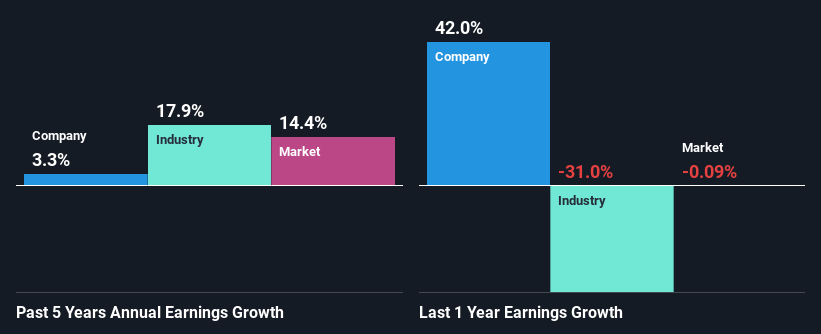Stock Analysis
- South Korea
- /
- Semiconductors
- /
- KOSDAQ:A110990
Digital Imaging Technology, INC.'s (KOSDAQ:110990) Stock Is Rallying But Financials Look Ambiguous: Will The Momentum Continue?

Digital Imaging Technology's (KOSDAQ:110990) stock is up by a considerable 48% over the past three months. But the company's key financial indicators appear to be differing across the board and that makes us question whether or not the company's current share price momentum can be maintained. In this article, we decided to focus on Digital Imaging Technology's ROE.
Return on equity or ROE is an important factor to be considered by a shareholder because it tells them how effectively their capital is being reinvested. Simply put, it is used to assess the profitability of a company in relation to its equity capital.
View our latest analysis for Digital Imaging Technology
How Is ROE Calculated?
Return on equity can be calculated by using the formula:
Return on Equity = Net Profit (from continuing operations) ÷ Shareholders' Equity
So, based on the above formula, the ROE for Digital Imaging Technology is:
7.1% = ₩13b ÷ ₩186b (Based on the trailing twelve months to December 2023).
The 'return' is the profit over the last twelve months. So, this means that for every ₩1 of its shareholder's investments, the company generates a profit of ₩0.07.
Why Is ROE Important For Earnings Growth?
So far, we've learned that ROE is a measure of a company's profitability. We now need to evaluate how much profit the company reinvests or "retains" for future growth which then gives us an idea about the growth potential of the company. Assuming everything else remains unchanged, the higher the ROE and profit retention, the higher the growth rate of a company compared to companies that don't necessarily bear these characteristics.
A Side By Side comparison of Digital Imaging Technology's Earnings Growth And 7.1% ROE
At first glance, Digital Imaging Technology's ROE doesn't look very promising. Yet, a closer study shows that the company's ROE is similar to the industry average of 6.8%. On the other hand, Digital Imaging Technology reported a fairly low 3.3% net income growth over the past five years. Remember, the company's ROE is not particularly great to begin with. So this could also be one of the reasons behind the company's low growth in earnings.
As a next step, we compared Digital Imaging Technology's net income growth with the industry and were disappointed to see that the company's growth is lower than the industry average growth of 18% in the same period.

Earnings growth is a huge factor in stock valuation. It’s important for an investor to know whether the market has priced in the company's expected earnings growth (or decline). By doing so, they will have an idea if the stock is headed into clear blue waters or if swampy waters await. Is Digital Imaging Technology fairly valued compared to other companies? These 3 valuation measures might help you decide.
Is Digital Imaging Technology Efficiently Re-investing Its Profits?
While Digital Imaging Technology has a decent three-year median payout ratio of 50% (or a retention ratio of 50%), it has seen very little growth in earnings. So there could be some other explanation in that regard. For instance, the company's business may be deteriorating.
Additionally, Digital Imaging Technology has paid dividends over a period of five years, which means that the company's management is determined to pay dividends even if it means little to no earnings growth. Upon studying the latest analysts' consensus data, we found that the company's future payout ratio is expected to drop to 5.7% over the next three years. Accordingly, the expected drop in the payout ratio explains the expected increase in the company's ROE to 23%, over the same period.
Conclusion
In total, we're a bit ambivalent about Digital Imaging Technology's performance. While the company does have a high rate of profit retention, its low rate of return is probably hampering its earnings growth. That being so, the latest analyst forecasts show that the company will continue to see an expansion in its earnings. Are these analysts expectations based on the broad expectations for the industry, or on the company's fundamentals? Click here to be taken to our analyst's forecasts page for the company.
Valuation is complex, but we're helping make it simple.
Find out whether DIT is potentially over or undervalued by checking out our comprehensive analysis, which includes fair value estimates, risks and warnings, dividends, insider transactions and financial health.
View the Free AnalysisHave feedback on this article? Concerned about the content? Get in touch with us directly. Alternatively, email editorial-team (at) simplywallst.com.
This article by Simply Wall St is general in nature. We provide commentary based on historical data and analyst forecasts only using an unbiased methodology and our articles are not intended to be financial advice. It does not constitute a recommendation to buy or sell any stock, and does not take account of your objectives, or your financial situation. We aim to bring you long-term focused analysis driven by fundamental data. Note that our analysis may not factor in the latest price-sensitive company announcements or qualitative material. Simply Wall St has no position in any stocks mentioned.
About KOSDAQ:A110990
DIT
DIT Corp. provides image processing and optical solutions in South Korea.
Exceptional growth potential with excellent balance sheet.

